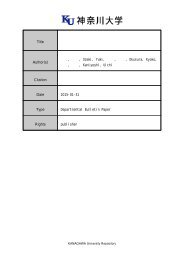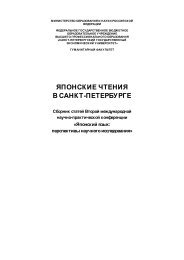to Learners with Special Educational Needs
e-textbook SEN
e-textbook SEN
Create successful ePaper yourself
Turn your PDF publications into a flip-book with our unique Google optimized e-Paper software.
Pokrivčáková, S. et al. (2015). Teaching Foreign Languages <strong>to</strong> <strong>Learners</strong> <strong>with</strong> <strong>Special</strong> <strong>Educational</strong> <strong>Needs</strong>:<br />
e-textbook for foreign language teachers. Nitra: Constantine the Philosopher University. 128 p.<br />
ISBN 978-80-558-0941-0<br />
planning skills and tracking homework, as well as instructing students on how <strong>to</strong> break down<br />
large projects in<strong>to</strong> smaller tasks help students completing long-term assignments.<br />
Textbooks used in English classes are not always possible <strong>to</strong> be changed; however, additional<br />
material may be modified the way in which they are presented <strong>to</strong> the learners. Current trends in<br />
language teaching materials go <strong>to</strong>wards a busy page, full of pictures and action. This might be<br />
very confusing for the learners <strong>with</strong> differences. Text windows made by cutting a hole in a paper<br />
or in ´L´ shaped pieces of paper that can be slid apart <strong>to</strong> change the size (Kormos and Smith,<br />
2014). Text windows are recommended and widely used mainly by dyslexic students. Within the<br />
holistic approach in inclusive English classrooms, all the learners may use tinted foils or cut-out<br />
text windows when they practice reading texts silently or out loud and thus the learners <strong>with</strong><br />
learning differences might not feel specially treated and on the opposite, the others may<br />
empathetically experience how it feels <strong>to</strong> be different. All in all, it might become an entertaining<br />
activity in order <strong>to</strong> enrich and vary teaching routines.<br />
The most important thing is <strong>to</strong> ensure that provided texts are large enough and in a font that<br />
can be easily read, <strong>with</strong> wider spacing. Recommended font is 12 point Arial, <strong>with</strong> clear text<br />
structuring, sometimes even numbering the lines.<br />
Students face classroom walls which are rarely white and empty. Teachers are promoted <strong>to</strong><br />
have colored posters, pictures, projects and other materials displayed all over the room.<br />
However, attention disorders frequently occurring in learners <strong>with</strong> differences might be<br />
disturbed by <strong>to</strong>o many pictures and displays. Scrivener (2011) recommends having walls<br />
around the board white and empty; however, suggests displaying additional materials (pictures,<br />
posters, etc.) in order <strong>to</strong> support multi-sensory perception. A reasonable use of visuals should be<br />
purposeful, refreshed after some time, or exchanged for something new. Nevertheless, project<br />
displays are important <strong>to</strong> support learners’ need for self-expression and fulfill purposefulness of<br />
classroom activities, as well as give reasonable feedback for a teacher and learners. Particularly,<br />
students <strong>with</strong> learning differences need <strong>to</strong> support their self-esteem in learning languages and<br />
be praised for even minimal success twice as much as other students. However, project displays<br />
should be preceded by personal presentation of the project and peer evaluation in order <strong>to</strong><br />
enforce critical thinking of students and accomplish their feeling of being important in the<br />
teaching and learning process.<br />
Hands-on approaches, strategies and techniques in English inclusive classrooms<br />
Multi-sensory approach involves the use of visual, audi<strong>to</strong>ry, and kinesthetic ways<br />
simultaneously <strong>to</strong> enhance memory and learning of written language. According <strong>to</strong> IDA (n.d.)<br />
links are constantly made between the visual, audi<strong>to</strong>ry and tactile language in learning <strong>to</strong> read<br />
and spell. All levels of language are addressed, often in parallel, including sounds (phonemes),<br />
symbols (graphemes), meaningful word parts (morphemes), word and phrase meanings<br />
(semantics, sentences - syntax), longer passages - discourse and the social uses of language<br />
pragmatics). Thus, all language systems are covered. DysTEFL (2011, pp. 48-52) summarizes<br />
practical key principles of the multisensory approach as follows:<br />
Provide opportunities for learners <strong>to</strong> practice and review a concept frequently <strong>with</strong>in the<br />
repetitive principle;<br />
Language should be taught in a logical progression and help students categorize concepts;<br />
Language concepts should be organized from simple <strong>to</strong> complex <strong>with</strong>in structured, sequential<br />
principles;<br />
Teachers should build on what learners already know and make connections between the<br />
known and the new information (so-called cumulative principle;<br />
Systematically and explicitly the phonemes or speech sounds of the foreign language should<br />
be taught;<br />
Sounds of the letters in English and the letters the sounds represent <strong>with</strong>in<br />
alphabetic/phonetic principle should be taught directly;<br />
34






